The Masurian Lakeland (Pojezierze Mazurskie) is Poland’s equivalent to the English Lake District. Situated in the northeast of Poland it has over 200 lakes surrounded by farmland, forest, and meadows. It is spectacularly beautiful and not surprisingly a popular tourist destination.
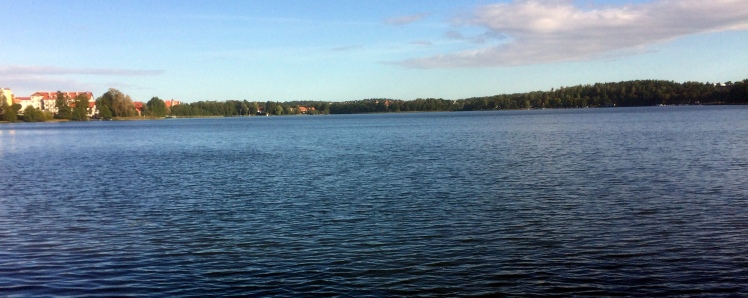
Historically though, it was part of the German Empire as East Prussia when it was known as Masurische Seenplatte. It was the only part of Germany directly impacted by The Great War when the Russian Army invaded at the start of WW1 and who were catastrophically driven back in two massive battles in late 1914 and early 1915. Following WW2, the area became part of Poland and the previous German place names were replaced by Polish equivalents.
Many of the lakes are connected by rivers or canals, by far the most impressive is the unfinished Masurian Canal (Polish: Kanał Mazurski, German: Masurischer Kanal) with its impressive lock systems including a huge iconic Nazi sluice. I have seen a couple of other unfinished canals with lock structures: the Cong Canal in County Mayo, Ireland and the Beat Bank Branch Canal in the town of my birth Denton, Manchester which was supposed to have connected the coal mines of Denton and Haughton to the (now filled in) Stockport Branch Canal. Neither, though both interesting, were on the scale of the Masurian Canal.
The Masurian Canal was an ambitious project to link the interconnected lakes of Masuria to the Baltic Sea with the intention of improving economic development of East Prussia together with providing an easy access for trade and passengers to the Baltic Sea. Apparently there had been plans for some sort of canal as far back at the 14th century and construction may have even been started before the project was abandoned. The idea wasn’t re-visited until 1862 with a revised plan to construct a canal that was able to carry ships with a displacement of up to 100 tons.
The proposal was to create a canal from the large Lake Mamry northbound via the River Lava to the River Pregolya and thus into Vistula Lagoon and onto the Baltic Sea. With a length of just over 50km and a drop in height of 111m the canal required 10 sluices. Approval was slow in coming, railway development was deemed more important, and it wasn’t until 1898 the East Prussian parliament finally approved the construction and allocated 200,000 Marks for the purchase of the required land.
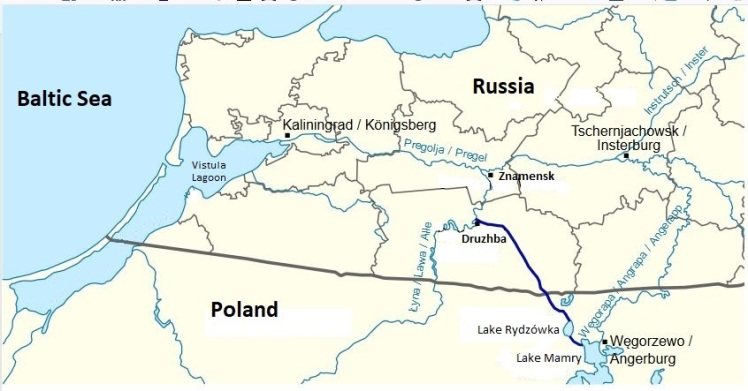
Funding was finally forthcoming in 1908 and following a redesign of the locks to support larger ships construction eventually started in 1911. But, it only lasted for 3 years when the outbreak of The Great War brought a full stop to proceedings.
After WW1 Germany was in turmoil politically, economically, and developmentally so work didn’t resume until 1920 but rising inflation and world economics brought construction to a halt again two years later. After the National Socialists came to power construction of the canal was restarted in 1934 as part of an activation program to re-generate the economy of East Prussia.
Once again it was deemed militarily important. Locks were updated, canal beds and embankments were strengthened, and bridges were modernized. Construction, using Organisation Todt and a huge labour force, was undertaken in complete secrecy and though the canal and its sluices were largely complete it was not shown on any map between the years of 1936-1939. Construction slowed in 1939 when much of the workforce was diverted to work on, firstly the construction of the nearby huge concrete metropolis that was headquarters of the Oberkommando des Heeres (OKH) (German Army High Command) at Mauerwald (modern day Mamerki), and then in 1941 Hitler’s field command headquarters on the Eastern Front – the Wolfsschanze (Wolf’s Lair – subject of a later blog).
By 1942 most of stretches the canal were carrying water, only a few sections and lock systems required further work. But in 1944, with the threat of the advancing Red Army, the canal was turned into a strategic defensive line and all road and railway bridges crossing it were blown up.
Following territory changes after WW2, the neglected canal is now dissected by the Polish-Russian border near the village of Brzeźnica. The southern, Polish section is about 20 km long and has five sluices. The Start of the canal from Lake Mamry to Lake Rydzówka is about 6km of which the first 5km is more or less complete and full of water. The last kilometre to Lake Rydzówka is unfinished with little water but has the huge and impressive pair of sluice (Polish -Śluza) structures at Leśniewo.
Onward from Lake Rydzówka to the Russian border the condition of the canal varies. Some sections contain water whilst others are incomplete or even filled in, but the sluices (starting nearest to Lake Rydzówka) at Śluza Guja (the most intact of the five sluices in Poland), Śluza Bajory Małe, and Śluza Bajory Wielkie remain largely intact.
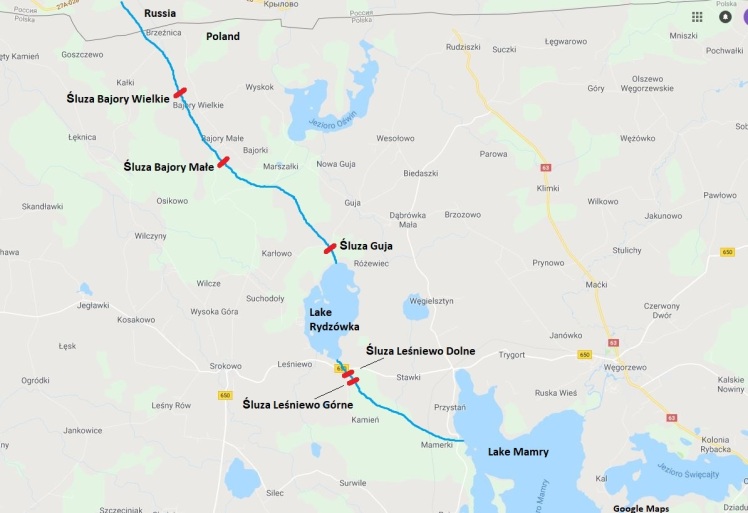
On a recent holiday in Poland I visited the two Leśniewo sites, but sadly not the other three. The Leśniewo locks are located near to Hitler’s Wolf’s Lair and Mauerwald. These three sites are architectural marvels. Like Wolf’s Lair and Mauerwald they are strikingly massive concrete citadels and though now largely overgrown and even though Wolf’s Lair is mainly destroyed they are impressive monuments like latter-day concrete Inca cities.
The Leśniewo sluices, despite their size are hidden away nestled in rolling farmland and forest about 1km from the road. The short walk to the first, or upper sluice,Śluza Leśniewo Górne, originally known by its German name Oberschleuse Fürstenau is along a (now) waterless canal embankment 8m above the surrounding area which is quite heavily forested, you don’t get to see the structure until you are practically upon it. The first site of the sluice is staggering: it’s huge and complex.
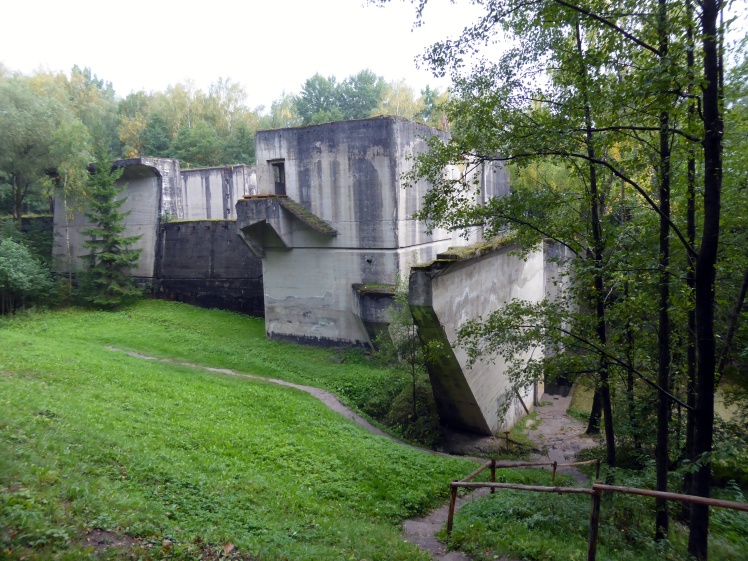
Apparently it was only ever about 70% finished. Constructed of reinforced concrete, neither of the lock gates or sluice apparatus were ever installed, though capstans remain installed in alcoves at regular intervals up both side walls of the lock chamber. The length of the chamber itself is 46m, 7.5m wide (the overall width of the lock is 20m), with a height 17m. The water depth of the chamber when full would have been 21m.
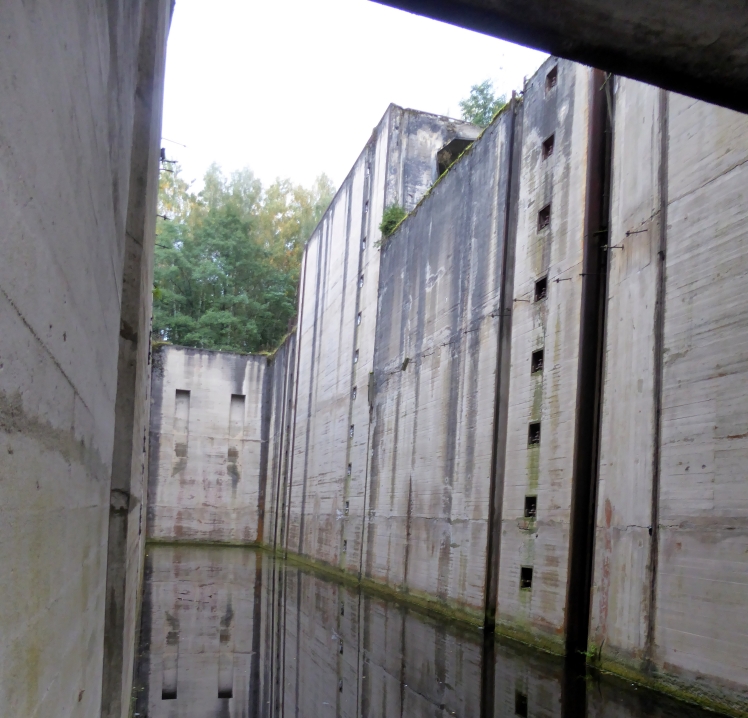
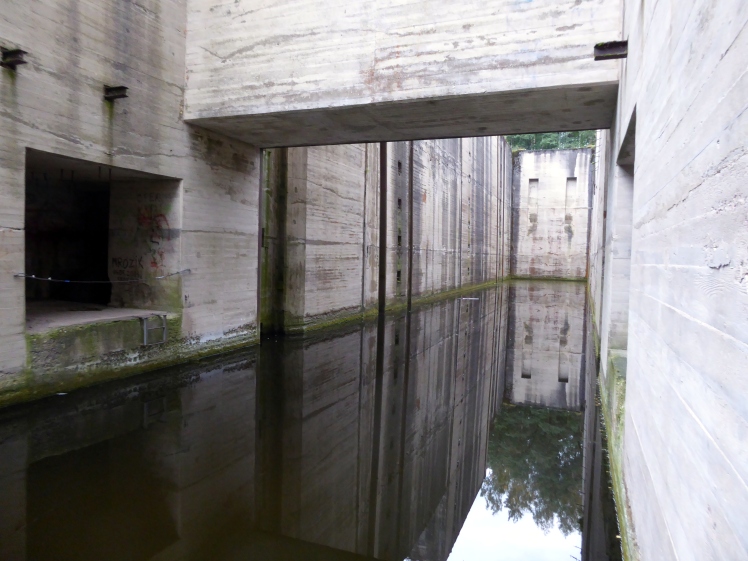
At first I couldn’t work out how the sluice would have operated as there is no apparent entry to the upper section of the lock from the canal. However, after further inspection and studying my photos its is clear that the crown of the lock is only partly installed, and the top lock gate aperture is completely missing. I also assume that some of the embankment filling is also missing and much of the structure we now see would have been below ground. Inside the lock chamber itself there are several rooms (some with rusty apparatus) for operating the filling valves and managing the bottom lock gates, though there is no bottom gate in place.
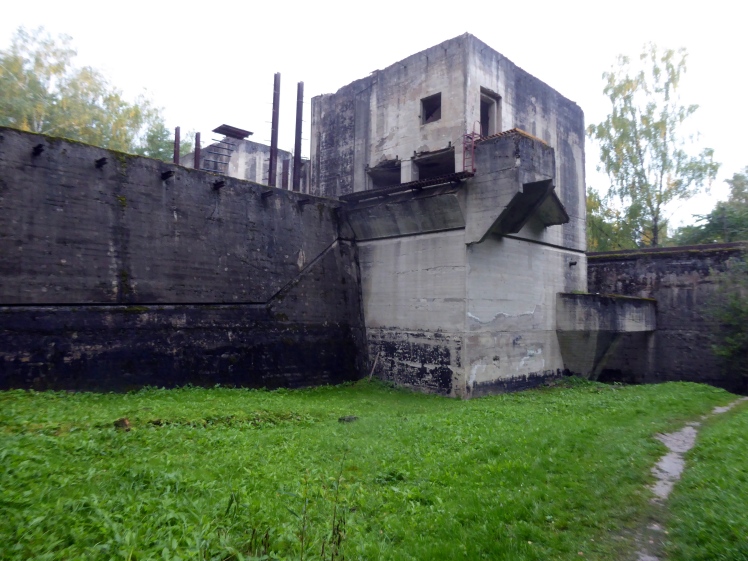
From the front, the view where the lower (northern) section of the canal would have been is spectacular. The structure is massive and surreal. It’s a huge concrete construction that almost defies description or purpose. High up in the centre of the façade there is a recess for a large Reichsadler Nazi eagle emblem. Local myth suggests that when it was being removed it fell into the water below and has never been recovered.
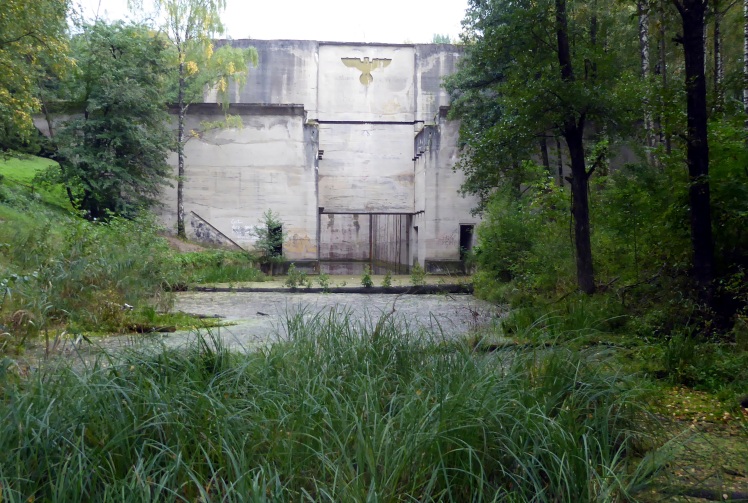
Around the outer western side of the lock there are signs that it might have been involved in some sort of fighting when the Russian Red Army moved in in early 1945 as there is clearly shrapnel damage to one of the upper walls.
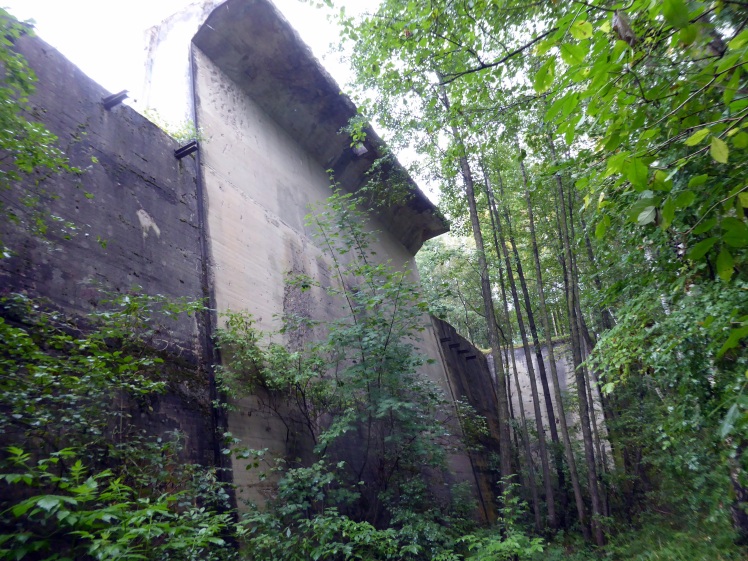
Unusually for Germany who seem to have a national obsession with photo-documenting most of their activities I have not been able to find any of historical photos of either the canal or the locks at Leśniewo when they were under construction.
About 900m further north towards Lake Rydzówka is the second of the Leśniewo sluices. Śluza Leśniewo Dolne (formally Unterschleuse Fürstenau) is the least advanced of the five Polish sluice systems and though only what appear to be the lower foundations remain it was planned to be the largest of the Polish Sluices. The drop in the canal level from the top of Leśniewo Górne to the bottom of Leśniewo Dolne would have been an impressive 33m.
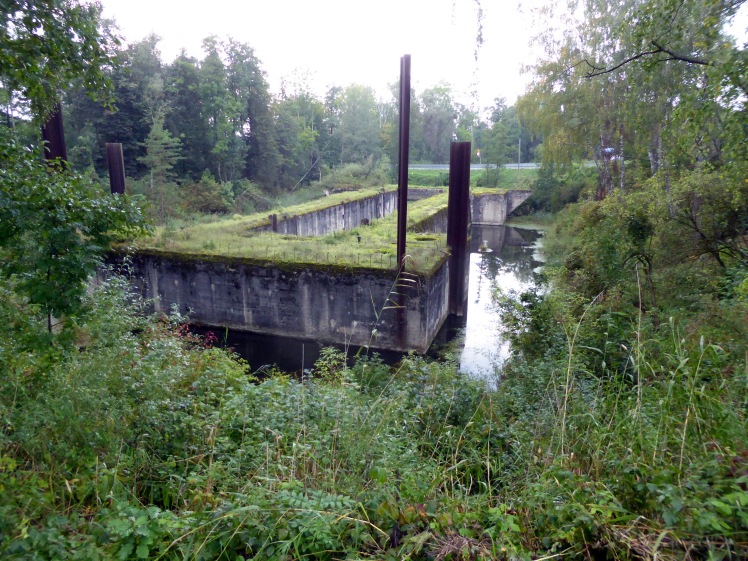
The short canal section from Lake Rydzówka to Leśniewo Dolne was originally complete and carried water, but it was filled in 1958, the little amount of water that trickles from the Sluices today flows through a culvert under a road and then via a stream into Lake Rydzówka.
The size of Śluza Leśniewo Dolne has given rise to much speculation and together with two huge concrete bunkers at Mauerwald close to Lake Mamry it has been suggested the they were secret construction and/or maintenance facilities for U-Boats that could connect directly to the Baltic sea. Who now knows the truth? But given the fact that the average depth of the canal was 2.3m and at some points only 1.2m and the draft of a typical U-Boat is 6.3m the story seems unlikely, but it hasn’t stopped a local museum at Mauerwald having a U-Boat display as one of its main attractions.
As I have said earlier these monuments don’t appear to be a main tourist attraction, but Śluza Leśniewo Górne is regularly used by an outdoor adventure group for climbing, abseiling, and canoeing. There is even a zip wire from the very top just above the Reichsadler down to canal level. Fortunately, it wasn’t operating the day I went so I didn’t have to suffer the embarrassment of having to decline an opportunity to partake.
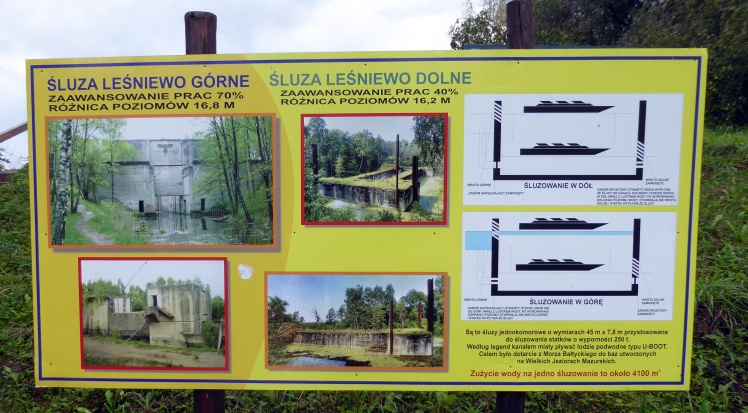
So back to the question in the header of this blog: Architectural marvel or hideous eyesore? For me, as I stated earlier, it’s a no-brainer. Set in beautiful Lakeland countryside with picturesque villages it is really impressive and well worth a visit. Ignoring their obvious historic associations, Śluza Leśniewo Górne together with the nearby Mauerwald and Wolfsschanze are all marvels of technology and engineering ingenuity. Though Hitler’s Reich didn’t last the 1000 years he boasted these concrete structures undoubtedly will.
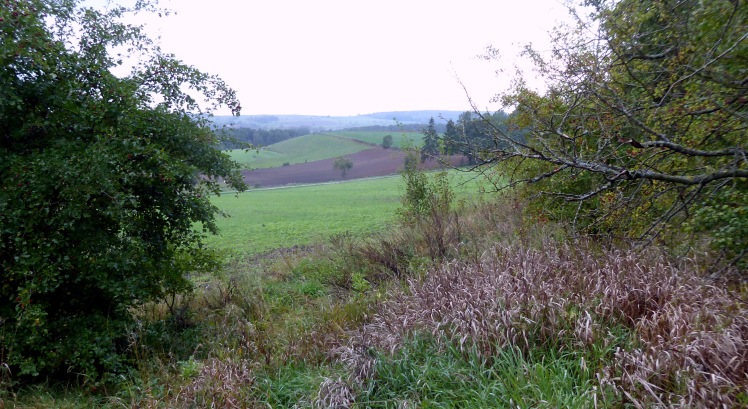
References
3D Model of Śluza Leśniewo Górne
Masurian Canal
http://battlefieldsww2.com/masurian-canal.html
https://www.youtube.com/watch?v=MOGmIo7MLMY
http://www.european-waterways.eu/e/info/poland/grosser_masurischer_kanal.php
https://travelblogeurope.com/the-abandoned-masurian-canal-prestige-project-from-hitler-germany/
https://www.mamerki.com/u-boot-i-wunderwaffe/index9ed2.html?lang=en
https://hiveminer.com/Tags/mamerki%2Cpoland/Timeline
Russian section
https://www.urbanghostsmedia.com/2014/04/mighty-abandoned-lock-masurian-canal/
Cong Canal
http://www.buildingsofireland.ie/niah/search.jsp?type=record&county=GA®no=30402722
Denton Beat Branch Canal
http://www.pittdixon.go-plus.net/ac-beat-bank-br/ac-beat-bank-br.htm
Brilliant Frank, interesting read. Who knew ? Incredible engineering. And Denton got a mention !
LikeLike